The Imaging Resource
Quick Review
Olympus Stylus 800 Digital Camera
|
|||||||||||||||||||||
Introduction
|
||||||||
The Olympus Stylus 800 Digital is reminiscent of the past Stylus 500 model, but with increased resolution, a refined user interface, and more control over the image capture process. Slightly off-center on the front of the camera, the lens is protected when powered off by an automatic sliding lens cover that locks into place when closed, unlike the sliding lens covers in most cameras that are only gently spring-loaded and easily bumped aside. When powered on, the lens cover slides quickly aside, and the telescoping lens zips out into place fairly quickly. While still relatively compact, the Stylus 800 is rather larger than its predecessor, with dimensions just slightly too large for most shirt pockets. Still, it should fit easily into coat pockets and most purses, and the all-weather body means you can take it just about anywhere. Although the camera cannot be submerged in water, it can withstand light rain and water spray without damage. The included wrist strap gives a little piece of mind, particularly since there's not a lot to grip on the front of the camera. I'd recommend picking up a soft case to protect the camera's attractive body panels from scratches.
The Olympus Stylus 800 Digital's metal body is one key to its all-weather rating, equivalent to IEC standard publication 529 IPX4 (which essentially means it can withstand water splashed from any direction). Inside the metal body, a plastic chassis provides the first level of protection against the elements. Rubber seals around compartment doors and even the lens mechanism also help prevent any leakage. Because the camera is so tightly sealed, Olympus designed an airflow control system to prevent the camera from overheating or building up air pressure from the zooming lens. Overall, the Stylus 800 Digital's all-weather design is an impressive feature on a digital camera, making it rugged enough to withstand much abuse -- from the weather or even a mischievous kid with a squirt gun. Water is anathema to most digital cameras, leaving me worried whenever I'm out shooting in even a slight drizzle. While the Olympus Stylus 800 isn't by any means an "industrial grade" digital camera, it's very comforting to know that random splashes of water and puffs of dust won't send it to an early grave.
The Olympus Stylus 800 Digital features a 3x, 8.0-24.0mm zoom lens (equivalent to a 38-114mm lens on a 35mm camera). Maximum aperture ranges from f/2.8 to f/4.9, depending on the zoom setting. The Stylus 800 Digital employs a contrast-detection autofocus system, with focus ranging from 1.6 feet (50 centimeters) to infinity in normal mode. A Macro setting focuses as close as 0.7 feet (20 centimeters) at wide angle, or 1.0 feet (30 centimeters) at telephoto. There's also a Super Macro option that gets as close as 1.2 inches (3.0 centimeters), for extremely close-in shooting. By default, the camera uses an iESP autofocus area setting, which automatically sets the focus based on the subject's proximity to a range of AF points around the center of the image area. Through the Record menu, you can opt for a Spot AF setting, which will instead base focus only on the very center of the frame. In addition to its 3x optical zoom, the Olympus Stylus 800 Digital also offers 5x Digital Zoom. Keep in mind though, that digital zoom simply enlarges the center pixels of the CCD and thus results in lower image quality. The 8.0-megapixel CCD produces high-resolution images, good enough for prints up to 16x20 inches with excellent detail and sharpness, as well as lower-resolution images for sending via email or for printing 5x7- and 4x6-inch prints. For composing images, the Stylus 800 Digital did away with the real-image optical viewfinder, and offers only the 2.5-inch TFT color LCD monitor, which features a very bright and clear display. I'm not a particular fan of cameras without optical viewfinders, but the viewfinder on the Stylus 800 is better in most respects than a lot of what's out there. Unlike many LCDs, the one on the Stylus 800 remains fairly visible in strong sunlight, so the need for an optical viewfinder in daylight shooting is largely eliminated. Under low light conditions, the Stylus 800's LCD screen actually stays visible to very low light levels, quite different from what I've become accustomed to on digital cameras in the past. Overall, the Olympus Stylus 800 seems to have addressed a lot of the problems we've seen in the past with LCD viewfinders. The LCD monitor provides a detailed exposure-information display which can include both shutter speed and aperture setting, as well as a live histogram for previewing the exposure graphically. In Playback mode, the LCD monitor provides image enlargement and an index display.
Exposure control on the Olympus Stylus 800 Digital is uncomplicated and straightforward, as is the case with most of Olympus' consumer-oriented digital cameras. The camera doesn't offer a completely manual mode, but a choice of both aperture-priority and shutter-priority modes plus a wide selection of preset Scene modes for specific shooting situations allow you to tailor photos to your liking. The Stylus 800 can be set to report the exposure values it's selected on-screen (as well as the values of most other settings that affect the final image, if they've been changed from the default). Most of the exposure options are controlled through the multi-page LCD menu system, which is fairly simple to navigate. An initial shortcut menu screen pops up before entering the main Record menu, offering quick-access options for the camera's White Balance, Image Size / Quality, and Exposure Compensation, or you can choose to just enter the main Record menu itself. The exposure mode is selected via the Mode dial, and as well as the program mode, an Image Blur Reduction mode, and an extensive selection of scene modes, you can also select Aperture-priority and Shutter-priority modes to have complete control over one variable, while the camera selects the corresponding value for the other. Shutter speeds vary from 1/1,000 to four seconds, and apertures from F2.8 (at wide angle) or F4.9 (at telephoto) to a minimum of F8.0. Other variables that the user can control include Exposure Compensation (to lighten or darken the image), ISO (the camera's sensitivity to light), White Balance (to adjust the color), Metering (to read light from the whole frame or just the center), and Flash modes. The Olympus Stylus 800's built-in flash operates in Auto, Red-Eye Reduction, Fill, and Off modes. ISO sensitivity on the Stylus 800 is particularly worthy of note. In the situations commonly encountered by consumers - birthday parties, for example - high ISO sensitivity can make the difference between getting the shot, or not (and also whether you have to use a distracting and unflattering burst of on-camera flash). The Stylus 800 allows you to trade off image resolution for extra sensitivity by combining pixels in the camera. The net result is that on top of the camera's 64 - 400 ISO range, you can also capture images at ISO sensitivities of 800 or 1600 at a reduced resolution of 2048 x 1536 pixels or lower.
The Scene menu (accessed by pressing the right arrow) offers Landscape, Landscape + Portrait, Portrait, Indoor, Sports, Beach & Snow, Behind Glass, Self Portrait + Self-Timer, Self Portrait, Sunset, Available Light Portrait, Night Scene, Night Portrait, Fireworks, Candle, Cuisine, Documents, Shoot & Select 1, and Shoot & Select 2 modes. Each mode sets up the camera for specific shooting situations, and a concise explanation of each mode appears on the LCD screen as you scroll through. Most of the preset modes are fairly self-explanatory, as they handle very distinct situations. However, the Shoot & Select modes deserve some explanation. Both modes access the camera's continuous shooting mode. Shoot & Select 1 locks focus with the first frame, where Shoot & Select 2 mode refocuses between each and every frame. In both modes, after shooting you are prompted to select which images you want to keep. The actual frame rate and the total number of images will depend on which mode you're using, as well as the image size and quality settings, and the amount of available space on the memory card. The Image Blur Reduction mode, which is accessed via its own position on the Mode dial, aims to reduce blur caused by moving subjects and camera movement when taking pictures. This is achieved by the camera combining multiple pixels into one, reducing the maximum image resolution to just 2048 x 1536 pixels or lower, and disabling the digital zoom function, but boosting the ISO sensitivity to as high as 2500 (!) and allowing significantly higher shutter speeds. In this mode, the longest shutter time the camera will shoot at is 1/20 second. Note too, that the extremely high ISO will result in very grainy images.
Other camera features include a Self-Timer / Remote Control mode, which provides a 12-second delay between the time the Shutter button is pressed and the image is actually captured. The Remote Control mode works with the optional RM-1 infrared remote control accessory, allowing you to fire the shutter from a short distance away, after a two-second delay. (This last can be very handy for shooting night scenes, when you don't want to jostle the camera by pressing the Shutter button.) The "2 in 1" photography mode records two vertically-oriented, half-sized images. After capture, the images are saved side-by-side in one image, giving a split-screen effect. A Continuous Shooting mode lets you capture a rapid series of images as fast as 1.2 frames per second, while holding down the Shutter button. A High-Speed Continuous Shooting mode allows frame rates as high as 4.2 frames per second, but locks image resolution to a maximum of 2048 x 1536 pixels. Actual frame rates and the total number of images will depend on the image size and quality settings, as well as the amount of available space on the memory card, but the burst length is limited to about 3 shots in large/fine mode, or about 13 shots in the reduced-resolution High-Speed Continuous mode. As with many Olympus cameras, a panorama mode is available when using Olympus brand xD-Picture Card storage cards (but not cards from third parties), and records as many as 10 consecutive images to blend into one panoramic image. The camera's Movie mode captures moving images and sound, at either 640 x 480, 320 x 240 or 160 x 120 pixels, at 15 frames per second. Maximum recording time depends on the resolution and available memory space. The camera's Playback menu offers a nice range of effects to choose from, including sepia tone or black-and-white color options, and a red-eye fix filter. (The red-eye fix seemed only marginally effective, but we actually had a bit of a hard time getting the Stylus 800 to produce red eyes in flash photos we snapped of ourselves in the first place.)You can also resize images to a smaller resolution more suitable for email. Another interesting feature on the Olympus Stylus 800 Digital is the ability to save images in groups or albums. You can save as many as 12 albums, each containing a maximum of 200 images. The Album setting on the Mode dial accesses saved albums, letting you select one for playback. (Note that Album options are only available when an xD Picture card is inserted in the camera; they aren't available when working with the internal memory only. A dual-time function lets you quickly set the camera to local time when travelling, and revert the change back to home time after the trip. An alarm clock function lets you travel a little lighter on the trip, leaving your alarm clock at home, so long as you're not a particularly deep sleeper.
The Olympus Stylus 800 stores images on xD-Picture Cards, or on 32MB of internal memory (of which 21.3MB is available for photo storage). High capacity cards are available, with sizes currently topping out at 1GB, and I suggest buying at least a 128MB xD-Picture Card along with the camera so you don't miss any important shots. A CD-ROM loaded with Olympus' Camedia Master software accompanies the camera, compatible with both Windows and Macintosh platforms (including Windows XP and Mac OS X). Camedia Master provides minor image editing tools, and the ability to "stitch" together multiple images shot in panorama mode, as well as utilities for organizing images. A second CD-ROM holds the camera's advanced instruction manual, which is more detailed than the basic manual that's included in book form. For power, the camera uses a rechargeable lithium-ion battery pack, and comes with a charger. For backup, I'd recommend picking up a spare battery pack and keeping it charged at all times, especially considering the large LCD monitor and lack of an optical viewfinder. The optional AC adapter is recommended for time-consuming tasks such as transferring images to a computer. Also included with the Olympus Stylus 800 is an AV cable for connecting to a television set, and a USB cable for connecting the camera to your computer to transfer images.
Basic Features
- 8.0-megapixel CCD.
- 2.5-inch color LCD display.
- 3x, 8.0-24.0mm zoom lens (equivalent to a 38-114mm lens on a 35mm camera).
- 5x Digital zoom.
- Automatic and aperture / shutter-priority exposure control, plus 19 preset Scene modes.
- Built-in flash with five operating modes.
- xD-Picture Card storage.
- 32MB of internal memory (21.3MB available for photos).
- All-weather, metal camera body.
- Power supplied by one lithium-ion rechargeable battery (included with charger) or optional AC adapter.
- Olympus Camedia Master software for both Mac and Windows.
Special Features
- QuickTime movies with sound.
- Continuous and High-speed Continuous Shooting modes.
- Image blur reduction mode boosts ISO sensitivity with decreased (2048 x 1536) pixel resolution.
- Self-timer for delayed shutter release.
- Panorama mode for stitching together multiple images.
- "2 in 1" multi-exposure mode.
- Black-and-White and Sepia color effects, plus Resize, and Red-eye Fix effects.
- Macro and Super Macro lens adjustment.
- White balance (color) adjustment with seven modes.
- Digital ESP (full frame) and Spot exposure metering options.
- Spot autofocus setting.
- Adjustable ISO to 64, 100, 200, or 400 equivalents, plus an Auto setting.
- Extendable ISO to 800 or 1600 equivalents at 2048 x 1536 pixel resolution.
- "Album" organization for favorite photos
- DPOF (Digital Print Order Format) compatibility.
- PRINT Image Matching III compatibility.
- DCF (Design rule for Camera File system) compatibility.
- Exif 2.2 compatibility.
- USB AutoConnect (no driver software needed) and USB cable.
- Video cable for connection to a television set.
Recommendation
The Olympus Stylus 800 Digital is yet another evolution in Olympus' popular
line of Stylus digital cameras. To my eye, it's one of the best Stylus models
to date, able to accommodate a broader range of shooting conditions than its
predecessors, and with a very solid "feel" in the hand. With relatively
compact dimensions, stylish design, and nice array of features, the Stylus 800
Digital could be a good match for novices and others interested in a compact,
rugged, and highly portable camera. Its all-weather body design means it can
go just about anywhere, and its below-average size makes it quite at home in
your shirt pocket. You get an 8.0-megapixel CCD, a very large 2.5-inch LCD monitor,
a good-quality lens, and an excellent selection of shooting modes, making the
camera very versatile in a variety of situations.
The Olympus Stylus 800 Digital retains a design similar to that of the previous Stylus 500 model, with a sleek, automatic lens cover that slips behind the front panel when the camera is switched on. Slightly larger and heavier than the previous model, the 4.1 x 2.3 x 1.3 inch (103 x 58 x 33 millimeter) Stylus 800 Digital is rather too big for shirt pockets but will fit most coat pockets and purses with ease. Despite its all-metal body, the Stylus 800 Digital is not as heavy as you might expect, at 7.3 ounces (207 grams) with battery and memory card. Thanks to its gently curved body panels, it fits the hand very well.
One of the most exciting design features on the Stylus 800 Digital is its all-weather body, complete with a double chassis (plastic underneath the metal body panels) and rubberized seals around the camera's openings. Olympus lists the cameras as compliant with IEC Standard publication 529 IPX4, which means that the camera won't be damaged by water spray from any direction. (The IPX4 test subjects products to 10 liters per minute of water at a pressure of 80-100kN/m2, for 5 minutes. What this means as a photographer is that the Olympus Stylus 800 is safe in rain, sleet, or snow, although it shouldn't be submerged in water. The all-weather design makes the camera that much more rugged, and likely to be taken everywhere you go. Although the camera is protected from the elements, I'd still recommend keeping it in a soft case to protect its fashionable appearance. The other exciting design element is the large and bright 2.5-inch color LCD monitor. Olympus eliminated the real-image optical viewfinder in favor of the larger LCD display, which is a more accurate (if rather more power-hungry) framing tool anyhow. As noted earlier, the "HyperCrystal" LCD on the Stylus 800 does a noticeably better job under both sunlight and low-light conditions than most other LCD viewfinders we've seen in the past.
The camera's front panel contains the 3x zoom lens, built-in flash, the self-timer lamp that counts down the 12-second delay before the shutter fires (in the very left-most corner of the flash window when looking from the rear), and the remote control receiver (to the left of the flash). The automatic sliding lens cover slides out of the way and behind the front panel when the camera is powered on, allowing the lens to extend forward. When closed, the circular cover fits neatly over the lens, and keeps the camera free of any protrusions that might hang on pockets. Unlike the sliding lens covers in most digital cameras, which are gently spring-loaded to hold them closed (and can be easily bumped out of the way when your camera is in a pocket, purse or bag), the Stylus 800's lens cap actually locks in place when the camera powers off, and cannot be bumped back open without powering the camera on - a far better design than most. A thin, sculpted silver ridge extends horizontally along the right side of the front panel from the lens, accommodating the Olympus logo but not really doing a lot to provide an extra grip on the camera body. A bundled wrist-strap will provide a little peace of mind against accidental drops, so long as you're sure to use it at all times. Also visible on the front panel is the camera's microphone, just above and to the left of the lens.
The opposite side of the camera is smooth and featureless.
The Stylus 800 Digital's user interface offers rather more exposure control than preceding "advanced point & shoot" Olympus digital cameras, although there's no fully manual mode. Still, thanks in part to a very helpful guide system, learning to use the camera shouldn't take too much time. A touch of the Power button brings the camera to life and, if the Mode dial is turned to a Record mode, extends the lens. Choices on the rear panel's Mode dial include Auto (camera icon), Image Blur Reduction (shaking hand icon), Scene, Shutter Priority, Aperture Priority, Movie, Playback, or Album modes. A multicontroller on the back panel serves two control two record-mode functions (including accessing Macro and Flash modes), and navigates through on-screen menus. It also scrolls through captured images in Playback mode, and pans around the images when using the playback zoom. The LCD menu system accesses the majority of the camera's exposure options, and features three or four tabs of options depending on the current operating mode (although some tabs have only a few settings). The subject tabs are shown down the left side of the screen. The initial shortcut screen quickly takes you to often changed settings, making operation even easier. Anyone already familiar with Olympus LCD menu systems should have no trouble, and even first-time beginners should get the gist of it after a few minutes.
Record Mode Display: The Stylus 800's record-mode screen always shows an information
overlay that displays the shooting mode, battery check, self timer / remote
control, alarm, dual time, AF target, number of images or length of movie remaining
on the camera's current storage medium, active memory type (xD-Picture card
or Internal), and a bar that serves as a visual indication of remaining storage
space. Half-pressing the shutter button adds focus confirmation and flash status
if required. Pressing the Display button pages through the available the available
display modes. On top of the basic mode display described previously, the regular
shooting display adds indication of the shutter speed, aperture, exposure compensation,
macro mode, drive mode, flash mode, sound recording, image dimensions and quality,
metering mode, ISO sensitivity, and white balance. Three further display modes
add either horizontal and vertical framing lines, diagonal framing lines, or
a live histogram display which replaces the pixel dimensions in the information
overlay at the bottom of the screen.
Playback
Mode Display: In playback mode, you can choose to have more or less image information shown in the overlay display, and most of the overlay disappears after a few seconds of not touching the controls, so you can (eventually) see just the photo itself plus an overlay indicating whether the photo is stored on an xD-Picture Card or the camera's internal memory. A third playback display mode shows a histogram, a small thumbnail of the image, and basic information including image quality and white balance settings, exposure compensation and ISO settings, and the date/time when the photo was captured. Using the zoom control, you can zoom out to a thumbnail display showing as many as 25 images at once, or to a calendar display showing one thumbnail per day for a month at a time, or zoom in up to 8x to check fine details and focus.
External Controls
Power Button: Tiny and recessed into the camera's top panel, this button
turns the camera on and off. When turned on in any record mode, the camera extends
the lens into its operating position. An adjacent LED illuminates when the camera
is powered on in any mode.
Shutter Button: To the right of the Power button, this circular
button is surrounded by raised plastic trim that helps prevent accidental bumps.
The Shutter button sets the camera's exposure when halfway depressed, and captures
the image when fully pressed.
Zoom Rocker Button: In the top right corner of the rear panel,
this two-way rocker button controls the optical and digital zoom (when the
latter is enabled) in Shooting mode. In Playback mode, this button controls
the digital enlargement of captured images, and also accesses the index and
calendar display modes.
Mode Dial: Below the Zoom Rocker button, this knurled dial controls
the camera's operating mode, placing it into Auto (camera icon), Image Blur
Reduction (shaking hand icon), Scene, Shutter Priority, Aperture Priority,
Movie, Playback, or Album modes.
Four-Way Multicontroller: Dominating the lower right corner of the rear panel, each of the four arrows on this rocker button points in a different direction (up, down, left, right). In any mode, the arrow keys navigate through menu options.
In Record mode, the up arrow button selects Flash modes, cycling through Auto, Red-Eye Reduction, Forced, or Off, and the down arrow selects the focusing mode, cycling through normal, Macro, or Super Macro modes.
In Playback mode, the right and left arrows scroll through captured images. When an image has been enlarged with the zoom control, all four arrows navigate within the view.
Menu / OK Button (see image above): In the center of the multicontroller rocker button, this button calls up the settings menu in both Record and Playback modes. It also serves as the "OK" button to confirm menu selections.
Quick View Button: At the top of a column of buttons lining
the left side of the LCD display, this button takes the camera to playback
mode displaying the most recently captured image, with all playback-mode
functionality available. Pressing this button a second time, or half-pressing
the Shutter button, returns to record mode.
Guide Button: Directly below the Quick View button, this button enables the camera's useful Shooting Guide function, which lists common photographic situations (such as "Shooting Into Backlight"), and guides you with suggestions on how to handle the situation (in this example, suggesting using spot metering, positive exposure compensation, or the camera's flash). For each suggestion, you are shown the specific buttons to press to perform the function. The list shown is identical whether you press the Guide button in Record or Playback mode.
Display Button: Directly below the Guide button, this button
selects from the available camera display modes. In Record mode, these are
Basic, Normal, Horizontal Framing Lines, Diagonal Framing Lines, and Histogram.
In Playback mode, the choices are Basic, Normal, and Histogram.
Self-Timer / Delete Button: Directly below the Display button,
this button selects between regular shooting, self-timer, and remote control
options in Record mode. In Playback mode (whether set via the Mode dial
or Quick View button), pressing this button calls up the the image deletion
menu, with a confirmation option before the image is deleted.
Camera Modes and Menus
Record Mode: Activated by turning the Mode dial to either the camera icon,
shaking hand icon, or the SCENE, S, or A positions, this mode sets up the camera
to take still pictures. The camera icon position sets the camera to Program
mode, while the S and A positions are Shutter-priority and Aperture-priority
respectively. The shaking hand icon position sets the camera to Image Blur Reduction
mode. 19 preset Scene modes are selected from on on-screen menu when the camera
is in Scene mode.
Movie Mode: This mode is marked on the Mode dial with a movie camera
icon. Here, you can capture moving images with sound at either 640x480, 320
x 240 or 160 x 120 pixels, at 15 frames per second.
Playback Mode: The traditional green Playback symbol marks this
mode on the Mode dial (a green arrow inside a green rectangle outline). Here,
you can scroll through captured images, add an audio caption, apply special
effects filters, or resize images.
Album Playback Mode: A green outline of a photo album denotes this
mode on the Mode dial. The Stylus 800 Digital lets you set up as many as 12
photo albums, each of which can contain 200 images. Album mode lets you view
the images in each album. Albums are created through the Playback menu.
Record Menu:
The following menu options are accessible by pressing the OK/Menu button in
either record mode. Some options may not be available in all Scene modes or
in Movie mode:
White Balance: Sets the color balance to Auto, Daylight, Cloudy, Incandescent, Fluorescent 1 (Daylight), Fluorescent 2 (Neutral), or Fluorescent 3 (Cool White) settings.
- Image Size/Quality: Sets the image resolution and JPEG compression level. Available resolutions are 3,264 x 2,448; 2,560 x 1,920; 2,272 x 1,704; 2,048 x 1,536; 1,600 x 1,200; 1,280 x 960; 1,024 x 768; and 640 x 480 pixels. Quality choices include SHQ (Super High Quality), HQ (High Quality), SQ1 (Standard Quality 1), and SQ2 (Standard Quality 2) JPEG compression levels. Movie mode options are 640 x 480, 320 x 240 or 160 x 120 pixels.
- Exposure Compensation: Increases or decreases the overall exposure from -2.0 to +2.0 exposure values (EV) in one-third-step increments.
- Mode Menu: Displays the following three-tab menu system:
- Camera:
Metering: Controls the camera's exposure metering system, selecting either Digital ESP (multi-pattern metering) or Spot (reads only from the center of the frame).
- Drive: Selects One-Shot, Continuous, or Hi-Speed Continuous Shooting capture modes. The Hi-Speed Continuous mode locks image resolution to 2,048 x 1,536 pixels or less, and disables manual selection of ISO sensitivity.
- ISO: Sets the camera's sensitivity to Auto or to 64, 100, 200, 400, 800, or 1600 ISO equivalents. When set to ISO 800 or 1600, image resolution is locked to 2,048 x 1,536 pixels or less.
- Digital Zoom: Turns digital zoom on or off.
- AF Mode: Lets you choose the autofocus area, either iESP or Spot.
- Audio Recording: Enables a four second recording that starts 0.5 seconds after the shutter is tripped.
- Panorama: Available only with Olympus brand cards, this mode captures as many as 10 consecutive shots to be stitched together on a computer into one panoramic image. You can select the direction in which photos will be captured - left, right, up, or down. Alignment guidelines appear on the screen to perfectly line up each shot, and the camera locks zoom position, focus, exposure and white balance with the first frame.
- 2 in 1: This mode lets you capture two vertically-oriented
"half" images which are fused together and saved as one
file (images are placed side-by-side). Thus, you can capture two individual
portraits and have them placed together in the same image, like a
split-screen view.
- Card:
Format: Formats the xD-Picture card or internal memory, erasing all files (even write-protected ones).
- Backup: Backs up photos from the camera's 21.3MB internal memory to a flash card, if sufficient space is available.
- Setup:
All Reset: If set to "On", certain settings will return to their defaults when the camera is powered off. When set to "Off", the settings are retained through a power-cycle. Affected settings are image size / quality, metering, white balance, exposure compensation, self-timer, macro, flash, drive mode, ISO sensitivity, digital zoom, AF mode, voice recording, and the most recently used display types in record and playback mode.
- Language: Sets the menu language to English, French, Spanish, or Portuguese.
- Power On Setup: Selects among three preset screen sounds and scenes that activate on power up, or disable the startup sound and screen altogether. Also offers two steps of volume control for camera startup sounds, or disables them altogether (which allows you to have a startup screen, but no startup sound).
- Color: Offers four menu color settings: Normal (gray and orange), Blue, Green, and Pink.
- Beep: Controls the camera's warning sound speaker volume with two steps of control available, or disables the warning sound altogether.
Shutter Sound: Selects among three shutter sounds and Off. For each shutter sound, you can choose a low or high volume option.
- Record View: Turns the instant image review on or off. When activated, instant image review briefly displays the most just-captured image after you trip the shutter.
- File Name: Selects whether the file and folder number are reset each time a new card is inserted, or retained from previous cards.
- Pixel Mapping: Checks the camera's CCD and image processing functions, maps out bad pixels. (You shouldn't need to do this more than once a year or so, and are recommended to wait at least one minute after the last picture was captured or viewed before using this function.)
- LCD Brightness: Adjusts the brightness level of the LCD monitor display, with +/- 7 arbitrary steps of brightness adjustment around the default.
Date/Time: Sets the camera's internal clock and calendar.
- Dual Time Setup: Allows you to enable or disable dual time mode, and if enabled allows you to set a time for your current location.
- Alarm Clock: Allows you to enable or disable the alarm clock function. If enabled, you can select between a one-time or daily alarm, and then set the time of day for the alarm, whether snooze is enabled, and which sound should be used. Three sounds are available, and each allows three possible volume levels. The alarm will only sound if the camera is turned off at the alarm time (but not if powered on or in sleep mode), and honors the dual time setting. The alarm will sound for a period of one minute, or until any button is pressed. If snooze is enabled, the alarm will activate up to seven times, at five minute intervals.
- Video Out: Sets the camera's Video Out signal timing to either NTSC or PAL.
- Camera:
Playback Menu: The following playback options are available through the Playback settings menu:
Slide Show: Calls up the slideshow menu, with two options. The confusingly named BGM option (perhaps "background mute?") selects whether or not sound recorded with still images will be played. The Type option lets you select a slideshow type - either normal, fader, slide or zoom. Pressing the OK/Menu button when not in these options initiates a slide show of all still images on the xD-Picture Card. (Another press of the OK/Menu button cancels the playback.) If a movie file is the first displayed, than "Movie Play" appears here instead.
- Album Entry: Displays the album setup screen. Here, you can select images to file in one of the 12 albums. You can either file single images by selecting them one frame at a time, or by selecting one image from each date on which images were captured, or you can choose to file all still images, all movies or all protected pictures into an album together.
- Protect: Protects the the currently-displayed image, preventing accidental
deletion by any means except formatting the xD-Picture card / internal memory.
- Mode Menu: Displays the following four-tab menu (unless viewing a movie file, in which case the first tab is not shown):
- Play:
Rotate: Rotates the displayed image 90 degrees clockwise or counterclockwise.
- DPOF: Marks the displayed image, or all images on the card, for printing on a DPOF (Digital Print Order Format) compatible printer. You can also establish the number of prints, whether or not the date and time are printed over the image, or remove the print mark.
- Record: Records four seconds of audio that is saved with the image as an audio caption.
- Edit:
Redeye Fix: Searches for and corrects redeye in images, and saves the results as a new file.
- Black & White: Converts the displayed image to black-and-white and saves it as a new file.
- Sepia: Converts the displayed image to sepia tone, giving it the appearance of an old-fashioned picture, and saves the converted image as a new file.
- Resize: Allows you to resize the displayed image to a smaller resolution (1,280 x 960, 640 x 480, or 320 x 240 pixels). The resized image is saved as a separate file. (Handy for photos you want to email.)
- Card:
All Erase: Erases all files on the xD-Picture card or internal memory, except for those that are write-protected.
- Format: Formats the xD-Picture card or internal memory, erasing all files (even write-protected ones).
- Backup: Backs up photos from the camera's 21.3MB internal memory to a flash card, if sufficient space is available.
- Setup: The Playback mode setup menu is very similar to the one in Record mode, the main differences being a volume control setting for playback of recorded sounds in place of the shutter sound option, an option to select one of your own images as the startup image of the camera, an option to select the number of images shown in thumbnail mode, and the removal of the record view, file name and pixel mapping options. No screenshots are shown here, but the menu looks very similar to the Record mode setup menu shown above.
- All Reset: If set to "On", certain settings will return to their defaults when the camera is powered off. When set to "Off", the settings are retained through a power-cycle. Affected settings are image size / quality, metering, white balance, exposure compensation, self-timer, macro, flash, drive mode, ISO sensitivity, digital zoom, AF mode, voice recording, and the most recently used display types in record and playback mode.
- Language: Sets the menu language to English, French, Spanish, or Portuguese.
- Power On Setup: Selects among three preset screen sounds and scenes that activate on power up, or disable the startup sound and screen altogether. Also offers two steps of volume control for camera startup sounds, or disables them altogether (which allows you to have a startup screen, but no startup sound).
- Screen Setup: Allows you to use the currently selected image as the third startup screen, which by default is simply a blank screen. If a user-selected image is already present, you are given the option to reset the existing image.
- Color: Offers four menu color settings: Normal (gray and orange), Blue, Green, and Pink.
- Volume: Sets the volume for movie and audio clip playback to Low, High, or Off.
- Beep: Controls the camera's warning sound speaker volume with two steps of control available, or disables the warning sound altogether.
- LCD Brightness: Adjusts the brightness level of the LCD monitor display, with +/- 7 arbitrary steps of brightness adjustment around the default.
- Date/Time: Sets the camera's internal clock and calendar.
- Dual Time Setup: Allows you to enable or disable dual time mode, and if enabled allows you to set a time for your current location.
- Alarm Clock: Allows you to enable or disable the alarm clock function. If enabled, you can select between a one-time or daily alarm, and then set the time of day for the alarm, whether snooze is enabled, and which sound should be used. Three sounds are available, and each allows three possible volume levels. The alarm will only sound if the camera is turned off at the alarm time (but not if powered on or in sleep mode), and honors the dual time setting. The alarm will sound for a period of one minute, or until any button is pressed. If snooze is enabled, the alarm will activate up to seven times, at five minute intervals.
- Video Out: Sets the camera's Video Out signal timing to either NTSC or PAL.
- Index Display: Lets you select how many images should be shown on-screen at once in the Playback mode's Index Display view. Choices are a grid of 2x2 (4 images), 3x3 (9 images), 4x4 (16 images), or 5x5 (25 images).
- Play:
In the Box
The Olympus Stylus 800 Digital ships with the following items in the box:
- Stylus 800 Digital camera.
- Wrist strap.
- Video cable.
- USB cable.
- Lithium-ion battery and charger.
- CD-ROMs loaded with Olympus Master software, drivers, and instruction manuals.
- Basic manual and registration kit.
- Larger capacity xD-Picture Card (at least 128MB).
- AC Adapter.
- Additional battery pack.
- Small camera case for protection.
Recommended Software: Rescue your Photos!
Just as important as an extra memory card is a tool to rescue your images when
one of your cards fails at some point in the future. We get a lot of email from
readers who've lost photos due to a corrupted memory card. Memory card corruption
can happen with any card type and any camera manufacturer, nobody's immune.
A lot of "lost" images can be recovered with an inexpensive, easy
to use piece of software though. Given the amount of email I've gotten on the
topic, I now include this paragraph in all my digital camera reviews. The program
you need is called PhotoRescue, by DataRescue SA. Read our review
of it if you'd like, but download the program now, so you'll have it.
It doesn't cost a penny until you need it, and even then it's only $29, with
a money back guarantee. So download PhotoRescue
for Windows or PhotoRescue
for Mac while you're thinking of it. (While you're at it, download the
PDF manual
and quickstart
guide as well.) Stash the file in a safe place and it'll be there when you need
it. Trust me, needing this is not a matter of if, but when... PhotoRescue
is about the best and easiest tool for recovering digital photos I've seen.
(Disclosure: IR gets a small commission from sales of the product, but I'd highly
recommend the program even if we didn't.) OK, now back to our regularly
scheduled review...
See camera specifications here.
Picky Details
Cycle times, shutter lag, battery life, etc. can be found here.
We ran the Olympus Stylus 800 through our usual battery of tests, and have summarized our findings here. To see the full set of our test images, with explanations of what to look for in them, see the Olympus Stylus 800 Sample Pictures page. For a complete listing of all our test and "gallery" shots, go to the Thumbnails page.
Not sure which camera to buy? Let your eyes be the ultimate judge! Visit our Comparometer(tm) to compare images from the Stylus 800 with those from other cameras you may be considering. The proof is in the pictures, so let your own eyes decide which you like best!
Lens
Zoom
A typical 3x optical zoom range, with good performance.
|
38mm
|
114mm
|
5x Digital Zoom
|
The Stylus 800 zooms over the equivalent of a 38-114mm range, which is a typical range for its class. Results are sharp at wide angle and telephoto, without any strong coma distortion. The 5x digital zoom takes it out to 15x total with the loss of quality that digital zoom creates.
Macro
A very small area in Super macro mode, slightly worse than average results in the normal macro setting. Flash almost throttles down enough, but still overexposes.
| Standard Macro | Macro with Flash | Super Macro Mode |
The Stylus 800's normal macro setting performs a bit below average, capturing a minimum area of 3.89 x 2.91 inches (99 x 74 millimeters). In Super macro mode though, results are much better, with a minimum area measuring 1.42 x 1.06 inches (36 x 27 millimeters). Detail is strong and resolution high in both shots, with only a moderate amount of softening in the corners from the lens. (Most cameras have some softening in the corners in macro mode.) The flash almost throttles down enough, but still overexposes the frame and creates a bright reflection in the brooch.
Distortion
Very high barrel distortion, moderate pincushion.
This is the tendency for the lens to bend straight lines outward (like a barrel--usually at wide angle) or inward (like a pincushion--usually at telephoto). The Stylus 800's 1.22% barrel distortion at wide angle is a fair bit higher than average among the cameras I've tested. At the telephoto end, the 800's 0.28% pincushion is moderate, and higher than average as well.
| Barrel distortion at 38mm is 1.22% |
| Pincushion at 114mm is 0.28% |
Chromatic aberration
Moderately high, small effect on images at edges.
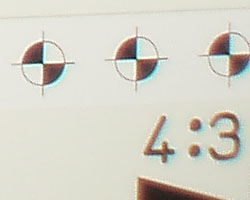 |
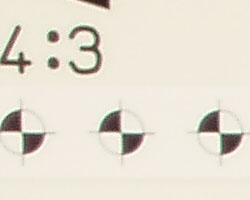 |
| Wide: moderate, bottom right @ 100% | Tele: virtually none, top right @ 100% |
Chromatic aberration is rather high at wide angle, showing about 6-7 pixels of fairly bright coloration on either side of the target lines, but there's almost no chromatic aberration at all at telephoto focal lengths. (This distortion is visible as a very slight colored fringe around the objects at the edges of the field of view on the resolution target.)
Corner Sharpness
Consistent sharpness from corner to corner, without any strong blurring.
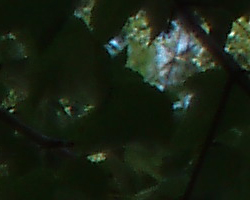 |
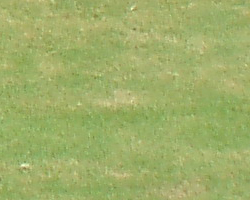 |
| Very slightly soft in the upper right corner, but hardly noticeable. | Consistent sharpness in the lower right corner. |
The Stylus 800 maintained a fairly consistent sharpness level throughout the frame, without strong blurring in any corner. (Much better than average in this respect.)
Sensor
Exposure and White Balance
Indoors, incandescent lighting
Strong red cast with the Auto white balance. Much better results with the Incandescent setting. About average exposure compensation required.
| Auto White Balance +1.0 EV | Incandescent WB +1.0 EV |
Color balance indoors under incandescent lighting was quite reddish in Auto white balance mode, though the Incandescent setting resulted in a much more pleasing color balance (despite a slight warm cast). The Stylus 800 required a +1.0 EV exposure compensation boost to get a good exposure, which is about average for this shot. Overall color is a bit dark and slightly yellow here, making the blue flowers very dark and purplish. (A very common outcome for this shot.) Our test lighting for this shot is a mixture of 60 and 100 watt household incandescent bulb, a rather yellow light source, but a very common one in typical home settings here in the US.
Outdoors, daylight
Good color balance, nice bright colors. About average exposure accuracy.
| Auto White Balance, +0.7 EV | Auto White Balance, Auto Exposure |
Outdoor shots generally showed nearly accurate exposure with slightly blown out highlights. Shadow detail was also somewhat limited, especially in bright exposures, but nothing too out of the ordinary for this class of digital camera. Exposure accuracy overall was about average, as the Stylus 800 typically required an average amount of positive exposure compensation.
See full set of test images with explanations
See thumbnails of all test and gallery images
Resolution
High resolution, 1,500 - 1,600 lines of strong detail.
Our laboratory resolution chart revealed sharp, distinct line patterns down to about 1,500 lines per picture height in the vertical direction, about 1,600 lines in the horizontal direction, with extinction occurring somewhere beyond 2,000. (The camera did produce very slight color artifacts at lower line frequencies though, visible in the full-sized res target shots.) Use these numbers to compare with other cameras of similar resolution, or use them to see just what higher resolution can mean in terms of potential detail. Beware that while you might be able to make out what looks like distinct lines at numbers higher than those we've mentioned here, the camera is just doing its best to continue interpreting the lines. If you zoom in and follow them from the wider portions, you'll see the lines converge and reappear several times, so the lines you see at 1,500 and higher are really only artifacts generated by the camera's imaging system.
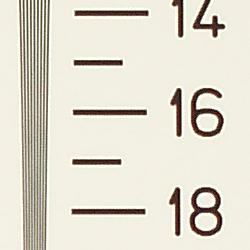 |
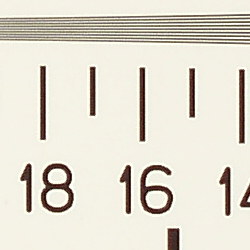 |
| Strong detail to 1,600 lines horizontal | Strong detail to 1,500 lines vertical |
See full set of test images with explanations
See thumbnails of all test and gallery images
Sharpness & Detail
Fairly sharp images, with some blurring of detail from noise suppression.
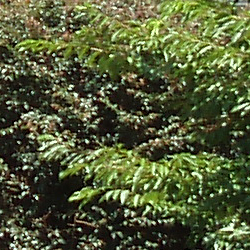 |
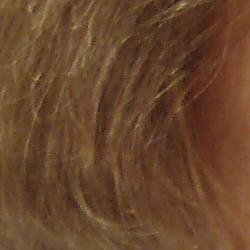 |
| Pretty good definition of high-contrast elements. | Subtle detail: Hair Noise suppression tends to blur detail in areas of subtle contrast, as in the darker parts of Marti's hair here. |
The Stylus 800's images are reasonably sharp, though with some over-sharpening and edge enhancement on the camera's part. (Edge enhancement creates the illusion of sharpness by enhancing colors and tones right at the edge of a rapid transition in color or tone.)
Noise-suppression systems in digital cameras tend to flatten-out detail in areas of subtle contrast. The effects can often be seen in shots of human hair, where the individual strands are lost and an almost "watercolor" look appears. The crop at far right shows this, with darker areas of Marti's hair showing very limited detail, and very soft definition even in the brighter strands.
ISO & Noise Performance
Moderate noise at the normal sensitivity settings, higher noise that blurs detail at the higher settings.
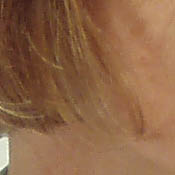 |
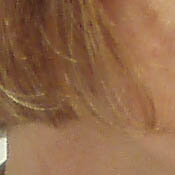 |
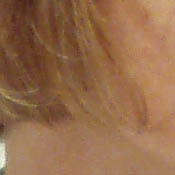 |
| ISO 64 | ISO 100 | ISO 200 |
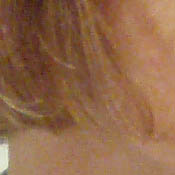 |
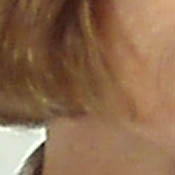 |
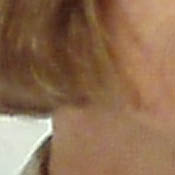 |
| ISO 400 | ISO 800 | ISO 1,600 |
The Stylus 800's lower ISO settings produce moderate noise, with some blurring of detail in the darker areas. As the ISO setting increases, so does the noise level and the amount of blurring that the camera's noise-suppression system introduces, and its images at ISO 400 are quite soft indeed. At ISO 800 and 1,600, noise is even higher, with much stronger blurring. ISO 800 and 1,600 are available only at the lower resolution setting, because the camera combines several sensor pixels for every output pixel to reduce noise levels. The result is fairly "clean" looking images, but with very poor resolution.
Extremes: Sunlit and low light tests
High resolution with good overall detail, though slightly high contrast and limited shadow detail. Pretty good low-light performance, capable of capturing bright images under average city street lighting and slightly darker conditions.
| +0.7 EV | +1.0 EV | +1.3 EV |
Sunlight:
Because digital cameras are more like slide film than negative film (in that they tend to have a more limited tonal range), we test them in the harshest situations to see how they handle scenes with bright highlights and dark shadows, as well as what kind of sensitivity they have in low light. The shot above is designed to mimic the very harsh, contrasty effect of direct noonday sunlight, a very tough challenge for most digital cameras. (You can read details of this test here.)
The Stylus 800 produced slightly high contrast with washed-out highlights and deep shadows in this test. A moderate noise level appears even in the lower highlights, and obscures definition of fine detail slightly. (This is balanced though, by the Stylus 800's high pixel count, so prints made from it tend to look pretty "clean," up to fairly large sizes.) To get reasonable midtones, we chose an exposure boost of +0.7 EV, despite the somewhat dark shadows. (In "real life" though, be sure to use fill flash in situations like the one shown above; it's better to shoot in the shade when possible.)
Low light:
Our low light testing revealed some limitations in the lens and sensor's ability to gather and process light, but the Stylus 800's performance in this area should be more than adequate for most consumers. Our test images were bright as low as 1/16 foot-candle, which is about 1/16 as bright as average city street lighting at night, only at the 800 and 1,600 ISO settings. At ISO 400, images were bright to 1/8 foot-candle, and at ISO 200, images were bright to 1/4 foot-candle. At ISOs 100 and 64, images were bright only to 1/2 foot-candle. (This means that the camera should do just fine under typical city night lighting.) Color balance was pretty good with the Auto white balance, despite a slight cool cast from the dim exposures. The camera's autofocus system worked unusually well, able to focus on the subject down to the darkest light levels we test at, without any AF assist. Do keep in mind that the slower shutter speeds used here definitely require use of a tripod to prevent any slight camera movement. (A useful trick is to just prop the camera on a convenient surface, and use its self-timer to release the shutter. This avoids any jiggling from your finger pressing the shutter button, and can work quite well when you don't have a tripod handy.)
Color
Saturation & Hue Accuracy
Good overall saturation, though slight oversaturation in bright reds and blues, very typical of consumer digital cameras. Generally good hue accuracy.
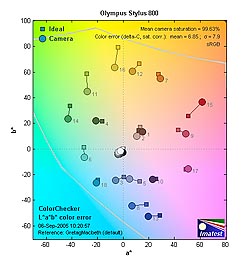 |
| In the diagram above, the squares show the original color, and the circles show the color that the camera captured. More saturated colors are located towards the periphery of the graph. Hue changes as you travel around the center. Thus, hue-accurate, highly saturated colors appear as lines radiating from the center. |
The other important part of color rendition is hue accuracy. Hue is "what color" the color is. Like most digital cameras, the Stylus 800 shifted cyan colors toward blue slightly, to produce better-looking sky colors. Unlike many cameras though, it shifted most blues away from purple, making for more pure-looking blues on prints. (Printers often have trouble with blues, rendering them with more purple in them than is apparent in real life.)
Viewfinder
Coverage
A pretty accurate LCD monitor, just a tiny bit tight.
| 38mm eq., LCD monitor | 114mm eq., LCD monitor |
The Stylus 800's LCD monitor showed about 98% frame accuracy at both lens settings. Since I generally like to see LCD monitors as close to 100% frame accuracy as possible, the Stylus 800's LCD monitor is just a hint tight here, but results are still good.
Flash
Coverage and Range
The Stylus 800's small flash has a limited range, and produces an orange cast in combination with typical incandescent room lighting. Our standard shots required more exposure compensation than average.
| 38mm equivalent | 114mm equivalent |
| Normal Flash, Default Exposure | Normal Flash, +1.3 EV |
Flash coverage was slightly uneven at wide angle but more uniform at telephoto. In the Indoor test, the flash on the Stylus 800 underexposed our subject at its default setting, requiring a +1.3 EV exposure compensation adjustment to get reasonably bright results. Even here, the exposure is a little dim, with a strong warm cast.
| 8 ft | 9 ft | 10 ft | 11 ft | 12 ft | 13 ft | 14 ft |
1/100 sec f4.9 ISO 64 |
1/100 sec f4.9 ISO 64 |
1/100 sec f4.9 ISO 64 |
1/100 sec f4.9 ISO 64 |
1/100 sec f4.9 ISO 64 |
1/100 sec f4.9 ISO 64 |
1/100 sec f4.9 ISO 64 |
Even at eight feet, our closest test range, the Olympus Stylus 800's flash had low intensity. Olympus rates the Stylus 800's flash as effective to about 11.5 feet at the telephoto lens setting, but we found that it had somewhat lower range at low ISO and with the lens towards the telephoto end of its range. The flash does illuminate the target, but intensity is quite low.
Output Quality
Print Quality
Good print quality, good color, very usable 13x19 inch prints. ISO 400 images are very soft at 8x10, acceptable at 5x7. ISO 800 is acceptable at 4x6 inches, ISO 1600 is soft even that small.
Testing hundreds of digital cameras, we've found that you can only tell just so much about a camera's image quality by viewing its images on-screen. Ultimately, there's no substitute for printing a lot of images and examining them closely. For this reason, we now routinely print sample images from the cameras we test on our Canon i9900 studio printer, and on the Canon iP5000 here in the office. (See our Canon i9900 review for details on that model.)
The Olympus Stylus 800's 8 megapixel resolution means it can produce very crisp images, usable at print sizes as large as 13x19 inches. - Provided, that is, that you give it enough light to work with. As its ISO (light sensitivity) level increases, its noise-reduction processing takes an increasingly heavy toll on subject detail, particularly in areas of subtle contrast. At ISO 400, its images start to look a little soft when printed at 8x10 inches, but probably acceptable to most users at that size. At ISO 800 and 1600, the camera forces you to use a lower resolution setting, as it combines image data from adjacent pixels to reduce noise, and also cranks up its anti-noise processing quite a bit higher. The result is images that are surprisingly noise free, but at the cost of significant subject detail. ISO 800 shots are really only usable for 4x6 prints, and ISO 1600 shots are soft-looking even when printed that small.
Timing and Performance
Olympus Stylus 800 Timing
Slightly lower than average speed for a consumer camera.
| Startup/Shutdown: | |
| Power On to first shot | 1.9 seconds |
| Power Off | 1.9 seconds |
| Shutter response (Lag Time): | |
|
Full Autofocus Wide
|
0.859 second
|
|
Full Autofocus Tele
|
0.757 second
|
|
Prefocused
|
0.089 second
|
| Cycle time (shot to shot) | |
| Normal large/fine JPEG | 1.67 seconds |
| Flash recycling | 8 seconds |
| Continuous mode, High | 0.24 second 4.18 frames/second (13 med/fine frames) |
| Continuous mode, Low | 0.84 second 1.19 frames/second (3 large/fine frames) |
| Download speed | |
| Windows Computer, USB 2.0 | 841 KBytes/sec |
The Stylus 800's performance ranges from about average to slightly slower than average, depending on what you're trying to do. Startup is about average, but flash recycling is a whopping eight seconds, long by any standard. Shutter lag is about average at both wide angle and telephoto. If you "prefocus" the camera by half-pressing and holding down the shutter button before the final exposure though, it's much faster, with a shutter delay of only 0.089 second. Shot to shot cycle times are average, at about 1.67 seconds for large/fine JPEGs, and it can capture up to five shots this quickly before it has to slow down and wait for the memory card to catch up -- Good performance for a compact digital camera model. Continuous-mode speed is quite good in the High mode, at a bit over four frames/second, for up to 13 medium/fine shots in succession. Connected to a computer, download speeds are fast enough that you probably won't feel a need for a separate card reader, but nonetheless aren't as fast as some cameras currently on the market.
Battery and Storage Capacity
Battery
Good battery life.
|
|
|
| Still-image capture mode LCD on |
156 minutes
|
| Still-image capture mode Half-press Shutter with LCD |
152 minutes
|
| Image playback |
379 minutes
|
The Olympus Stylus 800 has only a LCD monitor for image framing, which eats into battery time quite a bit, since you have no option to shoot without it. Even so, it doesn't do too badly in the battery life department, with worst-case run time of about two and a half hours. The Stylus 800 uses a custom rechargeable 3.7V, 1,230 mAh LiIon battery for power. The table above shows maximum run times based on our power measurements and the rated performance of its battery. Despite the relatively good run time, you should definitely consider purchasing a second battery to pack along on extended outings.
Storage
No card is included with the Stylus 800, although it accepts xD Picture Cards; 23MB of memory is built into the camera.
|
23MB Internal Memory |
Fine | Normal | |
| 3,264 x 2,448 | Images | 5 | 11 |
| File Size | 4.0MB | 2.0MB | |
| 2,560 x 1,920 | Images | 18 | |
| File Size | 1.2MB | ||
| 2,272 x 1,704 | Images | 23 | |
| File Size | 977K | ||
|
|
Images | 29 | |
| File Size | 785K | ||
|
|
Images | 34 | |
| File Size | 658K | ||
|
|
Images | 55 | |
| File Size | 417K | ||
|
|
Images | 84 | |
| File Size | 272K | ||
|
|
Images | 130 | |
| File Size | 176K | ||
I strongly recommend buying at least a 128MB card, preferably a 256MB one, to give yourself extra space for extended outings. (Here's a link to shop for xD memory cards for this camera.)
| Pro: | Con: |
|---|---|
|
|
| Free Photo Lessons | |
|


Follow Imaging Resource: